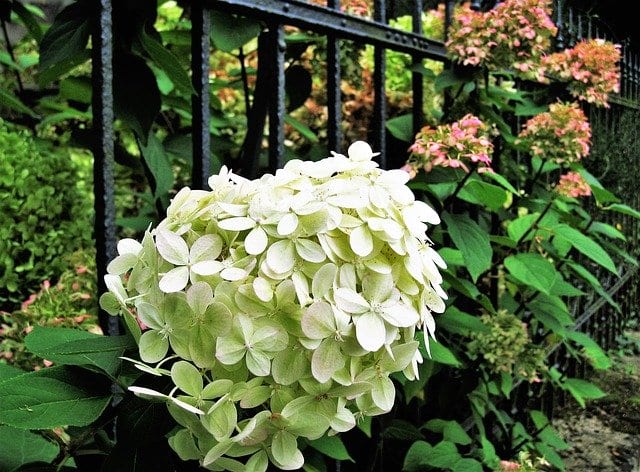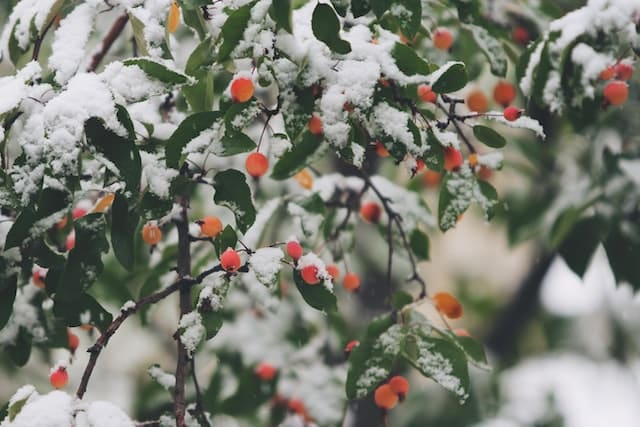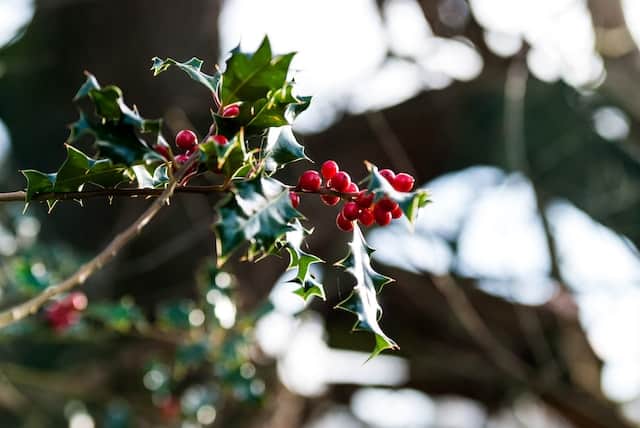
Minnesota landscaping for elegant winter interest consists of more than evergreen trees and shrubs.
There are many beautiful conifers and broadleaf evergreens, but when you open your mind to the textures and colors of sturdy flowers, branches, and seedheads, you’ll discover more elegant and uncommon design opportunities.
Deciduous trees and shrubs offer winter interest with persistent fruits, interesting bark and branching structure, colorful stems, and flowers capable of withstanding the full force of winter.
Family Favorite Crabapple Trees
The crabapple or Malus genus of ornamental trees are typically compact and suitable for providing winter interest. Apart from having breathtaking buds and blossoms in the spring, they are also attractive foliage plants in the summer and fall and provide a lot of fruit that lingers on the branches even during winter.
They come in different sizes and forms (most are less than 20 feet), making them able to fit in any space constraint. They are resistant to apple scabs and other diseases that have attacked crabapples in the past.
Some varieties such as the Sargeant Crab can be only 5- 10 feet in height, but it will spread up to twenty feet wide if desired. Depending on the crabapple cultivar, its shape may be rounded, vase-shaped, spreading, or columnar.
They do well under the full sun for a minimum of 6 hours daily. Blooming takes place in early to mid-spring, with the show often lasting for 3 weeks or more. They are considered moderately fast growers, but that is easily managed with periodic pruning.
The leaves of crabapple trees are usually green, but a few varieties have purple, red, or bronze foliage. During the fall, the color of the leaf may vary depending on the cultivar. They can be red, bronze, or orange.
The flowers come in the forms such as fully double,semi-double, or single, while the color will range from red, magenta, pink, or white. They also have a strong fragrance. Most have darker buds but lighten in color when the flowers fully bloom.
Their fruit ripens when summer is almost ending to mid-fall and usually clings to the tree’s branches throughout winter. The fruits are ordinarily red and look like tiny cherries. However, some cultivars can produce fruits that are orange, yellow, or maroon.

Ever Popular Red Twig Dogwood
The red twig dogwood, botanically known as Cornus sericea, is highly tolerant to cold.
The name originates from the bright red hue developed by their stem during winter. The color eventually fades during spring and summer and redevelops during autumn when the temperature becomes colder and the days shorter. They are more visible during winter when the plant is leafless.
It can tolerate any kind of soil, wet or dry, sand or clay, and acidic or alkaline. Though it’s best to avoid soils that are too wet because that may encourage the growth of mites that disfigure its beautiful red stems. Leaf spots might develop if the humidity is very high, making the plant less attractive, but it can’t damage it.
Unique and Durable Kentucky Coffetree
The ability of the Kentucky Coffeetree to tolerate pollution and a variety of soils makes it suitable for challenging urban environments. The tree has a leathery, reddish-brown seed pod that persists well through the midwestern winter landscape.
Yet, its true character is its interesting branching structure. Some simple stick figures that young children often draw. The shadows created by moonlight or landscape lighting can be truly stunning against a clean, snowy canvas.
Kentucky Coffetrees can be fast growers, but their upright habit will not overtake a landscape as a spreading oak tree might. It can tolerate alkaline soil, dry sites, occasional drought, road salts, and wet sites. It blooms mainly in late spring and early fall. It must be exposed to the full sun for at least 6 hours daily.
To get the best landscaping design, you should consider contacting professionals with the necessary experience and who are familiar with the best trees and shrubs that will last through the winter period.
Elegant and Varied Hydrangeas
Hydrangeas like Grandiflora, Annabelle, and Limelight are also great choices for winter interest in Minnesota landscaping design. The flower heads of these plants provide your garden with texture and variety that lasts for the duration of the winter landscape.
In addition to your outdoor environment, dried hydrangea flowers can be re-purposed inside the home. They can be combined with fresh flowers, stand on their own, or mixed with other winter-effect plants. For example, dried hydrangea flowers mixed with red-twig dogwood stems, and a few boxwood or holly branches make an excellent display.
Versatile and Friendly Arborvitae
This includes flat-leaved evergreens. They are softer to the touch and perform more like a broadleaf evergreen. They can be used for screening and windbreaking during the winter.
Winter arborvitae, also known as wintergreen, has a deep green color and a fast growth rate. They are durable enough to stay standing during winter storms and are not bothered by the same diseases and ailments that plague spruce trees.
Evergreens can provide a Minnesota landscape design with year-round color and texture. They make great accent plants.
Minnesota Native Black Alder
Black Alder is native to Minnesota and is a fast-growing tree that grows to medium size. The leaves of this tree are dark green, round, glossy, and toothed. These trees are popular in moist and wet soil conditions. The seeds of this tree grown in flats during the wintertime will germinate in the spring when they are lightly covered with soil.
Black Alder is especially nice for a winter landscape because the bark of this tree is smooth and gray and has a beautiful aesthetic during winter in contrast with the snow.
As you can see, there is so much more to winter landscape than just traditional conifer trees and shrubs. Colorful foliage, interesting bark colors, and persistent fruits or berries bring an aesthetic perfect for the winter months and your Minnesota landscaping.
To round out this conversation, explore the qualities of boxwoods and hollies, which are both evergreen and colorful.
Trusted and Timeless Boxwoods and Hollies

Many people find it difficult to differentiate between boxwood and small-leaved hollies. They both have small, dark evergreen leaves, but there are hollies that drop their leaves in the winter just as brilliant red berries reveal their true winter character.
You can distinguish boxwoods by branches that are opposite each other, making pairs. whereas holly leaves are arranged in alternate patterns. The leaves on boxwood have smooth edges, while holly leaves have tiny scallops on the edges. Holly has leaves that are slightly darker than boxwood leaves.
Both boxwood and holly have tiny flowers. Boxwood has both male and female flowers on the same plant and has aquamarine, star-shaped flowers, but it doesn’t produce berries.
On the other hand, holly has small white flowers and requires a separate male and female plant to form berries. After pollination, hollies produce small, blue-black berries.
Boxwoods and hollies will flourish in acidic, well-drained soil with full or partial sun. They both gain their formal character from careful pruning. Yet, this practice should be performed no later than early fall to avoid encouraging new growth that may not harden off before winter.
A few boxwoods will turn into copper color in winter, while holly remains dark green. Both plants will be more attractive if they are protected from drying winter winds.
Architectural Landscape Design: Helping Homeowners Enjoy Better Living
Here at ALD, our top priority is creating living spaces that are right for you. Our landscape design team will work with you from concept to construction to create the right landscape for your personal needs. Contact us today for a free consultation to explore your next outdoor living project.
